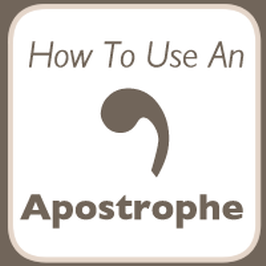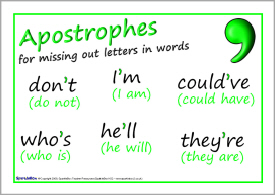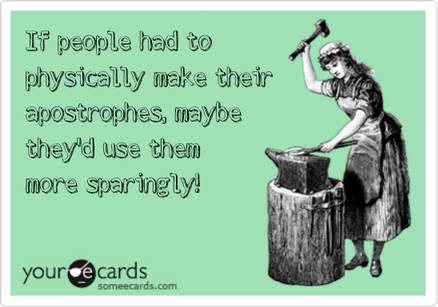07/2014 - The Grammar-Us Blog - Grammar-Us
Main menu:
Avoiding Apostrophe Apocolypse
 Like the comma, about which I wrote in last week’s post, the apostrophe is a misunderstood and misused punctuation mark. That’s why I have chosen to dedicate this week’s post to it.
Like the comma, about which I wrote in last week’s post, the apostrophe is a misunderstood and misused punctuation mark. That’s why I have chosen to dedicate this week’s post to it.
Look at the last sentence of the preceding paragraph, and you will see an illustration of the two primary uses of apostrophes:
1. To indicate possession. In the sentence above, this would be the word “week’s.” (Another example would be: The dog’s coat was sleek and shiny.)
2. To indicate a contraction. In the sentence above, this would be the word “That’s.” (Another example would be: Isn’t it strange that no one is here yet?)
Reason #1 above is pretty self-
There is one notable exception to this rule, to which I devoted a blog post some weeks ago. That is the word “its.” When an apostrophe is added to “its,” it means “it is.” Without the apostrophe, it means “belonging to it.”  Reason #2 is the most misunderstood reason, in my humble opinion. Perhaps a good rule of thumb is to remember that a contraction is an instance where something is being omitted, and the apostrophe takes its place. For example, “can’t” is a contraction of “cannot.” “Didn’t” is a contraction of “did not.” Similarly, when writing about a specific decade, you can replace “19” in “1970s” with an apostrophe. (Example: Bell-
Reason #2 is the most misunderstood reason, in my humble opinion. Perhaps a good rule of thumb is to remember that a contraction is an instance where something is being omitted, and the apostrophe takes its place. For example, “can’t” is a contraction of “cannot.” “Didn’t” is a contraction of “did not.” Similarly, when writing about a specific decade, you can replace “19” in “1970s” with an apostrophe. (Example: Bell-
There is one very important reason for NOT inserting an apostrophe: To indicate a plural. For instance, if you are referring to the entire Hartman family, you should NOT write, “The Hartman’s.” Instead, you should write “The Hartmans.” Adding an “s” or “es” to a word makes it a plural. Adding an apostrophe “s” makes it a possessive.
BONUS TIP: Many people face a conundrum when confronted with a word that ends in “s”: Where does the apostrophe go (or is an apostrophe even needed)?
Many people face a conundrum when confronted with a word that ends in “s”: Where does the apostrophe go (or is an apostrophe even needed)?
Typically, if the word is possessive, you DO need an apostrophe, and it should often be followed by an “s.” For example: “We’re going over to the Jones’s house for dinner tonight.” It would also be correct to write, “We’re going over to the Jones’ house for dinner tonight.”
When a word ends in “s” and the next word starts with “s,” you do not need another “s” after the apostrophe. For example: “Texas’ state bird is the mockingbird.”
Let's Pause To Honor The Comma!
Three Speech Patterns That Can Compromise Professionalism
A Hit Parade of Grammar Misses
- FRESH WRITING
- TWELVE ERRORS THAT MAKE A GRAMMARIAN GNASH HER TEETH
- THE WHYS AND HOWS OF WRITING AN EFFECTIVE CONSUMER LETTER
- FILLER WORDS: THE "JUNK FOOD" OF COMMUNICATIONS
- Pardon Me, Your Participle is Dangling!
- MAKE BETTER GRAMMAR A NEW YEAR’S RESOLUTION
- The Value Of Personal Letters
- How To Make Your Writing Flow
- How (And Why) To Tighten Up Your Writing
- Why Grammar Matters
- Time For Another Grammar Quiz!
- Editing: The "Make Or Break" Skill
- Proofreading: It Matters More Than You Think!
- Please Don't Ruin A Perfectly Good Tense!
- A Brave New Word
- Homophones: The Sequel
- Coulda, Shoulda, Woulda And Other Incorrectly Written Words
- More Homophones
- Time For Another Grammar Goof Quiz
- A Different Kind Of Colonoscopy (And Semi-Colonoscopy)
- Comparatives & Superlatives: The Good, The Bad, And The Ugly
- Either/Or, Neither/Nor: Decisions, Decisions!
- Let's Agree To Agree
- Avoiding Apostrophe Apocolypse
- Let's Pause To Honor The Comma!
- Three Speech Patterns That Can Compromise Professionalism
- A Hit Parade of Grammar Misses
- Negative Nancy Has Hijacked My Blog!
- Who Dat?
- Avoiding the Ill Effects of Misusing "Affect"
- How To Perfectly Use Six Irregular Verbs
- Random Ramblings
- Me, Myself and I: The Narcissist's Nightmare
- Confounding Compounds
- "All The World's A Stage...": Know Your Audience
- From The Department Of Redundancy Department: The Whole Entire Scoop On "Whole" And "Entire"
- Grammatically Challenged? There, Their, They're. It'll Be OK!
- "Its": It's a Special Exception
- We're Up And Running!